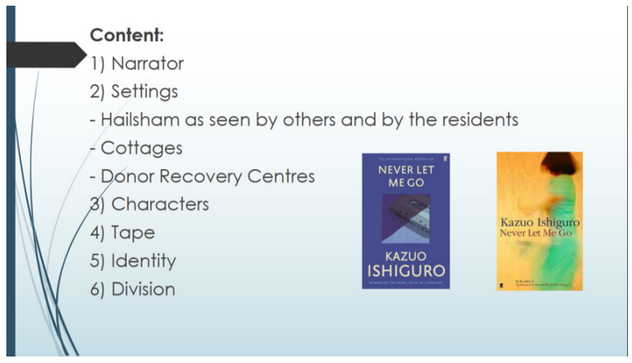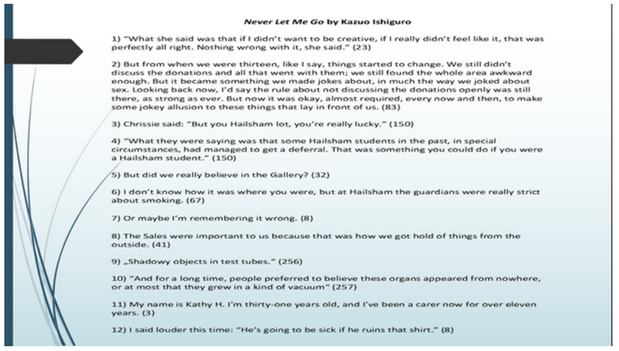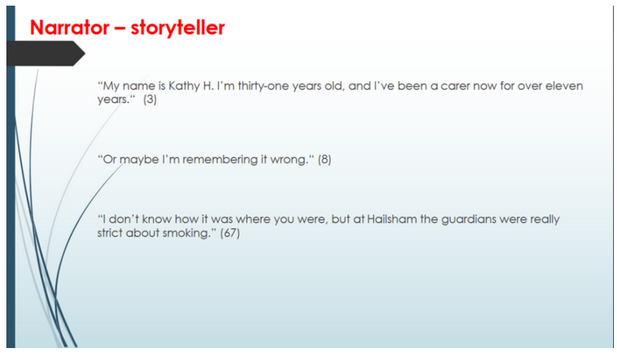Teaching Kazuo Ishiguro’s Novel Never Let Me Go and Improving Reading Skills
Alenka Blake is a high school teacher of English and German in Slovenia (I. gimnazija v Celju). For twenty-five years she has been teaching, while also co-translating works of literature, picture books for children, and scholarly publications. All this time she has been interested in bringing innovative approaches into her classroom, teaching English and German through music, film and literature. Email: alenka.blake@prvagim.si
Introduction
Reading literary works in English is a fine way of continuing to learn the language. It offers a myriad of benefits, from extending vocabulary, to developing a feel for the syntax and style of English, while of course also bringing out topics for interpretation, thus engaging students into thinking and expressing their thoughts in English. These processes are not simple and they need to be taught with a well-thought-out plan. My plan this year was to teach and discuss a novel primarily by using quotations from it. Students were not introduced to biographies or any other context because it could have turned out to be a departure from the text. Such an approach might have invited them to rely on online notes or summaries. This article is based on classroom experience and it presents an approach to reading literature by looking closely at the text and being able to use this close textual analysis to write a well-balanced literary essay.
Teaching a novel by quotations alone
Teaching English as the first foreign language in the final year of an academic high-school (“gimnazija” in Slovene and “Gymnasium” in German) in Slovenia means teaching students who have undergone a decade of language instruction. At the end of their secondary education they take a state exam called the “matura”. To pass the exam in English they have to study literature (both prose and poetry), alongside the usual grammar topics, such as word formation and sequence of tenses. One of the literary works assigned this year (2023) is Kazuo Ishiguro’s novel Never Let Me Go. The matura exam offers two levels: basic and higher. Students opting for the latter have to write a literary essay on a topic from Ishiguro’s novel.
At this point I encounter problems since some students in their essays tend to summarise and describe rather than analyse and interpret. Of course they are given a series of thorough instructions on writing literary essays and on what it means to argue and support your arguments. Several practice essays are analysed in class in order to allow them to learn about weak points and the ways they can improve them. After all, not every essay fulfills the criteria of a good literary essay. Oftentimes the problem lies not only in lacking writing skills but also in not having much to say beyond restating factual information about the work in question.
“Creating content” is a popular phrase these days. It is, however, difficult to create content when writing a literary essay in a foreign language if your reading is superficial, quick and not focused due to the various excuses and reasons students may come up with – such as being busy with other subjects and admissions of time mismanagement. For this reason, I regularly remind students during English lessons of the deadline up to which they have to have read the novel. Reading books for school can be a burden, as students often do not particularly enjoy reading the books they have been assigned, or reading literature at all. Some students read a book to get the gist of it, to get the story and this is where they halt; others reach for online summaries and synopses. When students read for leisure, it is less problematic as no one is going to ask questions and demand interpretation.
Reading a book in a foreign language for class discussions is a complex matter. Ideally it is similar to studying for other subjects in the humanities, such as history. One should underline passages, make notes, etc. Consequently, reading for school is different from daily reading on social media and therefore of less interest to some students. To quote the introduction from David Greenham’s Close Reading: The Basics, one could talk about “the tension between what we can intuitively enjoy and what happens when we slow reading down and begin to analyse our enjoyment by focusing on particular words and quotations – that is by close reading.” Funny Tweets or Instagram captions are, in contrast, understood and enjoyed at a blink.
As Greenham suggests, close reading offers the solution to the aforementioned problems of superficial reading. It is important to teach this skill – especially in the light of the fact that in Slovenia and in Central Europe as a whole there has been less of a tradition of argumentation and students are more tempted to reach for secondary literature for interpretation instead of focusing on the text and self-analysing it. In short, many students’ concept of literary interpretation consists of memorising names, dates and lists of themes. Close reading means being observant to words, details and how they are presented, to ideas, characters and their development and so much more. My intention is to teach students to read closely and to help them realise that such reading is rewarding, worth the time spent. It is through close reading and the ensuing analysis that one learns about the world around us, forms an attitude to things and people, evaluates things morally and ethically, and finally learns about oneself. One pays attention to words, their meaning and connotations (e.g., “guardians” vs. “teachers”), and sentence types (declarative and blunt or periodic?), all of which improves students’ English. They run into new words in a particular context, elicit the meaning or meanings of those words, and become more familiar with words they might passively understand but are not yet comfortable using, and so on. A good example from Never Let Me Go would be the word “deferral”. Many of the students were familiar with the word “referral” but were unaware of the existence of the word “deferral,” whose meaning they were able to derive from the more familiar word. After going through the process of reading closely and weighing the textual evidence carefully, it becomes far less difficult to create an essay with well-supported arguments. Why? Because they are writing on the basis of textual evidence.
To develop the skill of close reading, I decided to teach Never Let Me Go almost solely on the basis of quotations. This approach means that every topic from the novel is discussed by closely examining relevant lines and passages. Because the quotations are limited to individual sentences or shorter passages, it is easier for the students to immerse themselves into the text and observe structure and style as well as content. When reconsidering the novel through quotations, the aesthetic value comes to the fore. A seemingly simple sentence such as “The problem, as I see it, is that you’ve been told and not told” (Ishiguro, 79) reads differently in terms of rhythm and expectations if we shift “as I see it” to the first position, or if we replace “you’ve” with “you have,” or “and” with “but” in “been told and not told”. Such considerations are crucial for developing young ears for the delights of English.
To turn to how form and content mix, seeing quoted parts of dialogues by different characters makes students realise what a particular character is like and how they are different from each other. Do they use contractions? Formal language? Slang? Complicated syntax? Teaching through quotations is also extremely practical for the students. Careful examination of quotations leads them to zero in on the most important topics from the novel and at the same time reminds them of the most relevant events. This focus comes in handy later as well, when they revise the novel alone before the exam. Students get into the habit of reading closely and realise that details of various kinds matter. Not only are they valid when reading a book but also in our daily lives. As Brummet writes, “In a world in which messages ask us increasingly to believe, accept, buy and follow, the ability to read texts closely is an indispensable survival skill” (6). Literature indeed gives us lessons for life and transfers knowledge from the classroom to the street, so to speak.
If reading abilities benefit from such a process of teaching a novel, writing improves as well. Through classroom discussions around a relevant quotation students realise that they need to do exactly the same when writing their matura essay – that is, interpret and support the interpretation with the specific incidents and evidence from the novel. It is the events from the story that lead to an interpretation. Therefore, students are not in danger of slipping into pure summarising of the novel instead of writing a literary essay with a thesis and arguments. Having a few short sentences or passages from the story up your sleeve is always handy when writing as it strengthens one’s authority on the subject matter.
Outline of the lessons
The first lesson starts with an outline of how the lessons will follow chronologically. As the slide below shows, we begin with the narrator, then move on the settings and characters, etc. When discussing topics in a novel, one often travels from one part of the story to the other. Having a clear plan is comforting for the students, as it contributes to clarity of knowing how the lessons will proceed. The plan, however, is not rigid: certain events from the story can be discussed under various topics. For example, the first sentence in the novel – where Kathy H. introduces herself – can be discussed under the topic of the narrator as well as the topic of identity. Literary works are complex and one occurrence can convey multiple layers of meaning. By clearly knowing which topic is being discussed at a specific classroom moment, confusion is kept to a minimum. Moreover, students can see how various topics intertwine and they will, one hopes, be less inclined to breaking literary works down to a series of bullet-point themes.

Students get a list of thirty-five quotations with page numbers from the book. We all used the same Faber edition, which of course facilitates finding passages. The quotations are not in any particular order. They are also of various lengths: some are shorter and some are longer. Each quotation has a number so the students can easily make notes. If they are still using pen and paper, they can simply put down the title of the topic, the number of the quotation and make notes in connection to it. Students form groups and decide which quotations are relevant for the topic discussed. This is a useful exercise because students have to read carefully and closely (also, students who have not finished reading the novel can still participate in class). Once the quotations are chosen, the discussion begins. Groups argue in what way their quotation is relevant to the topic.

Here is an example about how the lesson progressed. The first topic on the content list is “narrator.” Students chose the following quotations:

I copied the lines on the board and the discussion in English followed. The first quotation sounded to the students like a confession, of the sort one might see in movies depicting Alcoholics Anonymous meetings. There is a personal introduction to strangers, and, rather than saying “I am an alcoholic,” Kathy H. confesses to having been “a carer […] for over eleven years” (Ishiguro, 3). Students realised that the story is a first-person narration with a very honest narrator, Kathy H. She tells us about herself and even admits that she might not remember things accurately. The advantages and disadvantages of the first-person narration were discussed. Students recognised the benefits of getting the story from Kathy, the protagonist. They receive her firsthand experience, yet this is limiting at the same time, especially if the narrator herself is doubting her recounting of the events – there is a clash between the seeming specificity of “now” and “eleven years,” since we at that point do not know exactly when the story takes place.
What further puzzled the students is the narrator’s truncated name: Kathy H. The initial instead of the surname remains a secret to the end (so as with the time references) there is a mixture of specificity and vagueness. Looking up “Kathy H.” online would be as difficult as figuring out a year on the basis of “now” and “for over eleven years.” Some students were reminded of the way cat and dog litters are named, namely, where dogs or cats of the same litter have names with the same initial letter. This is an interesting point of view, as Kathy and other characters in the book are clones and are regarded as “Shadowy objects in test tubes” (256), without families or any other close family members. From the beginning of the novel, when Kathy introduces herself, we sense that there is something special and different about her and the Hailsham students. As we read on, the truth about their purpose in life – donating vital organs for “normal people” (69) – is revealed.
While reading closely, students noticed how the pronoun “you” in the last quotation pulls the reader into the story (“I don’t know how it was where you were, but at Hailsham the guardians were really strict about smoking” (67)). It is expected that the reader might have the same experience. Here the questioning of the experience in conjunction with the reader arises. Some students believed Kathy is writing down the story for other donors to read, since she is telling the story at the stage in her life when she is clearly aware of them being organ donors for “normal people” (69). At the same time, everyone can relate to the quotation about not being allowed to smoke in school, as we all were students at some point in our lives. It can also be that Kathy does not differentiate between people and she simply tells the story to anyone interested. Students, in the end, agreed that it does not really matter who the story is meant for. This is beside the point, they argued. Addressing the reader is a literary device that kidnaps the reader into the world of Hailsham students, makes them part of the story and does not let them go without engaging with the morals of the story.
Conclusion
To discuss the planned topics, I needed 15 lessons of 45 minutes each. Throughout the lessons students were active and engaged. My experience proved, at least to me, that dealing with a novel via quotations is very useful as the students have to think and express their thoughts. According to Annette Federico “literary works demand the exercise of cognition and emotion, intellect and intuition” (7). Again, I was reminded that reading literary works is truly beneficial. Close reading generates fruitful debates in the classroom because each student inevitably interprets the words on the page. Students learn how to listen carefully to fellow students and how to reach a consensus in interpretation, which all together leads them to better understanding the novel read. Dealing with the text through quotations makes students reread the novel through different eyes. The story imprints itself on the students and the possible gaps they have in understanding the novel, which might have been created by sloppy and superficial reading at home, are filled. The students get the most important parts of the novel served on a quotation-platter, which is useful for home revision but not superficial in way a summary-platter might be. Close reading can hopefully bring more pleasure in reading and make students better and more observant readers. Only in that manner are they well equipped to write a quality literary essay.
References
Brummett, B., (2010), Techniques of Close Reading, Sage.
Federico, A., (2016), Engagements in Close Reading, Routledge.
Greenham, D., (2018), Close Reading: The Basics, Taylor and Francis, Kindle Edition.
Ishiguro, K., (2005), Never Let Me Go, Faber.
An Introduction to Accessibility
Tom Lennard, FranceTeaching Kazuo Ishiguro’s Novel Never Let Me Go and Improving Reading Skills
Alenka Blake, SloveniaDeveloping Presentation Skills: The Simulated Conference
Anila R. Scott-Monkhouse, ItalyTeaching Expository Writing to ESP 4th Year Medical Students
Pedro E. Rodríguez Rodríguez, Cuba;Ania Agustina Gómez GómezPositive Psychology in the Secondary EFL Classroom
Tamara Schüszler, HungaryTales of Strays ACTION!
Margarita Kosior, Greece/Poland